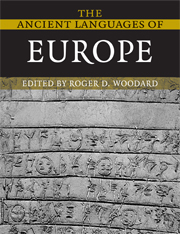Book contents
- Frontmatter
- Contents
- List of figures
- List of tables
- List of maps
- List of contributors
- Notes on numbering and cross-referencing
- List of abbreviations
- Preface
- Preface to the first edition
- 1 Language in ancient Europe: an introduction
- 2 Attic Greek
- 3 Greek dialects
- 4 Latin
- 5 Sabellian languages
- 6 Venetic
- 7 Etruscan
- 8 Continental Celtic
- 9 Gothic
- 10 Ancient Nordic
- Appendix 1 Indo-European
- Appendix 2 Full tables of contents from The Cambridge Encyclopedia of the World's Ancient Languages, and from the other volumes in the paperback series
- Index of general subjects
- Index of grammar and linguistics
- Index of languages
- Index of named linguistic laws and principles
6 - Venetic
Published online by Cambridge University Press: 01 September 2010
- Frontmatter
- Contents
- List of figures
- List of tables
- List of maps
- List of contributors
- Notes on numbering and cross-referencing
- List of abbreviations
- Preface
- Preface to the first edition
- 1 Language in ancient Europe: an introduction
- 2 Attic Greek
- 3 Greek dialects
- 4 Latin
- 5 Sabellian languages
- 6 Venetic
- 7 Etruscan
- 8 Continental Celtic
- 9 Gothic
- 10 Ancient Nordic
- Appendix 1 Indo-European
- Appendix 2 Full tables of contents from The Cambridge Encyclopedia of the World's Ancient Languages, and from the other volumes in the paperback series
- Index of general subjects
- Index of grammar and linguistics
- Index of languages
- Index of named linguistic laws and principles
Summary
HISTORICAL AND CULTURAL CONTEXTS
The Venetic language is attested by approximately 350 inscriptions that have come to light in the territory of pre-Roman Venetia in northeastern Italy. The inscriptions cover a span of nearly five hundred years, dating from the final quarter of the sixth century to the middle of the first century BC. The spoken language did not survive Roman colonial expansion and the spread of Latin into the northeastern portions of the Italian peninsula during the second and first centuries BC. Venetic has no modern descendants.
Venetic inscriptions have been found at sites scattered throughout most of pre-Roman Venetia as well as in territories lying to the north and east. The community of Adria, which is situated in the Po River valley a few kilometers inland from the Adriatic Sea, marks the southern limit. The rock inscriptions at Würmlach and the votive texts from Gurina, both sites located in the valley of the Gail River in Austrian Carinthia, mark the northernmost boundary. Venetic inscriptions have been uncovered as far east as Trieste at the head of the Adriatic.
The most abundant source for Venetic inscriptions is the sanctuary of the goddess Reitia at Baratella just east of Este. The religious sanctuary at Làgole di Calalzo in the valley of the Piave River is another principal source, yielding nearly a quarter of the total number of Venetic texts.
- Type
- Chapter
- Information
- The Ancient Languages of Europe , pp. 124 - 140Publisher: Cambridge University PressPrint publication year: 2008
- 1
- Cited by



